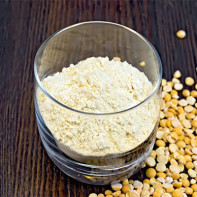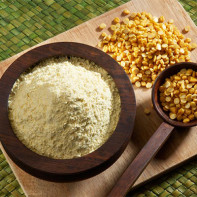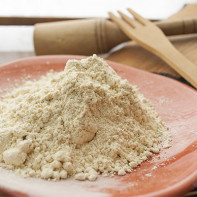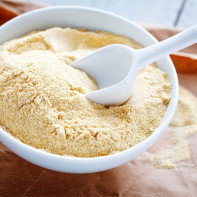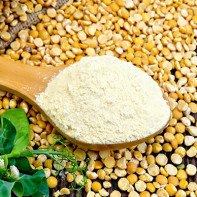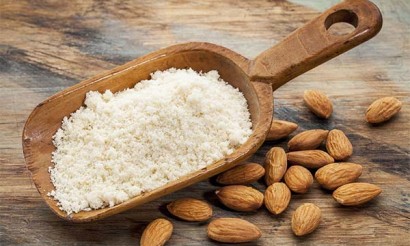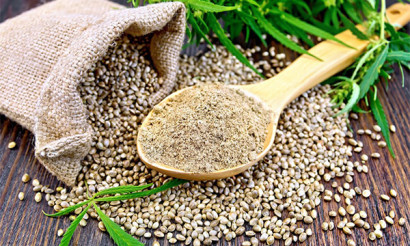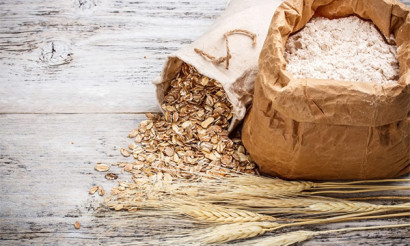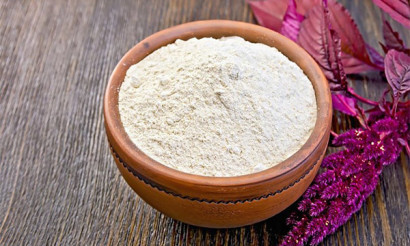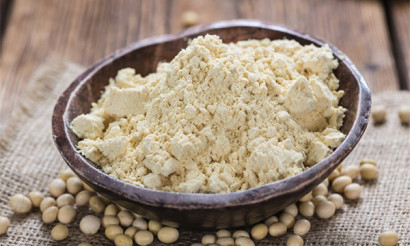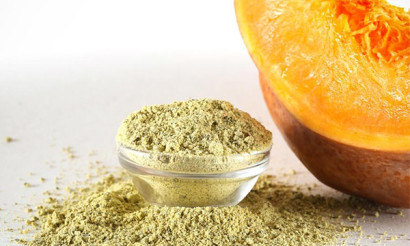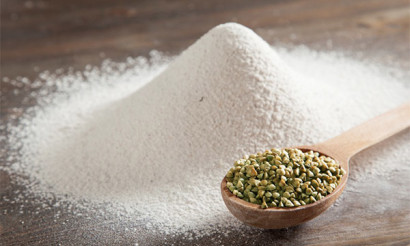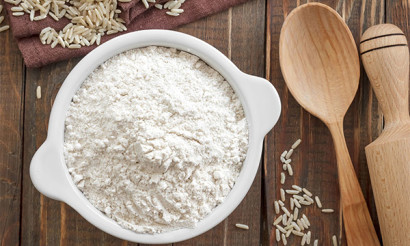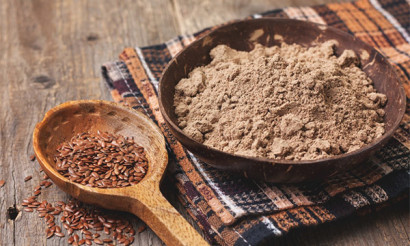Pea flour: useful properties and contraindications
Pea flour is a product of processing dried peas. Although in the old days it was widely used in traditional Russian cuisine, over time it has been forgotten. But today, when there is a growing interest in healthy eating, and many people have to look for gluten-free products, pea flour is becoming popular again.
- Composition and calories
- What are the benefits of pea flour
- The use of pea flour in medicine
- Pea meal in cosmetology
- For Face
- For Hair
- Harm and Contraindications
- How to choose and store
- How to make pea flour at home
- What can be cooked from pea flour: Recipes
- Pancakes
- Pancakes
- Porridge
- Soup
- Kissel
- Interesting Facts about Peas
Composition and calories
Pea meal can not be called a low-calorie product. The energy value is 298 kcal per 100 g. However, if you look at the composition, it becomes clear why it is called dietary.
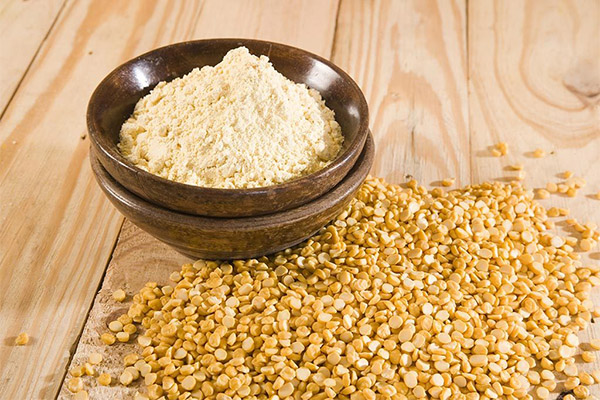
Pea flour contains 20-30% protein, which is perfectly assimilated by the body. It also surpasses wheat flour in the content of vitamins, macro-and micronutrients and useful amino acids such as lysine and threonine. At the same time, the chemical composition of pea flour makes it suitable for making different baked goods and confectionary products, where it replaces wheat flour.
Pea flour contains the following elements (in 100 g):
- Vitamin B1 (54% of the daily allowance). It is the most important element of carbohydrate and energy metabolism. It is responsible for metabolism, helping the body get energy rather than storing fat reserves. It is also necessary for normal functioning of the central nervous system and the cardiovascular system.
- Vitamin B5 (pantothenic acid, flour contains 44% of the daily allowance). It is essential for carbohydrate, protein and lipid metabolism. It normalizes blood cholesterol levels, is involved in the synthesis of hormones, including by maintaining the function of the adrenal cortex. Its deficiency leads to a deterioration of the skin and mucous membranes.
- Choline (40% of the norm). This substance is part of lecithin, which makes it the most important ingredient for lipid metabolism. It improves the condition of the liver and helps to get rid of fat reserves.
- Vitamin H (38% of normal). Helps break down fats and promotes the absorption of amino acids, including those found in pea meal. It is also responsible for the beauty and youthfulness of the skin.
- Vitamin PP (32.5% of the norm). It plays an important role in metabolic processes. Provides a normal digestive process, a beneficial effect on the nervous system, improves skin condition.
- Vitamin B6 (13.5%). Increases the body's natural immunity, is responsible for normalizing lipid metabolism, regulates appetite, ensures youthfulness and healthy skin.
- Potassium (34.9% of the daily requirement). Necessary for the regulation of water balance, is involved in the cardiovascular system, regulates blood pressure.
- Phosphorus (41.1 percent of the daily allowance). Necessary not only for metabolic processes, but also for the mineralization of teeth and bones, and to improve mental performance.
- Magnesium (26.8 percent of the daily allowance). It is necessary for normal absorption of calcium and sodium. It prevents the development of cardiovascular disease and helps to fight seizures.
- Selenium (23.8%). This element has antioxidant and immunomodulatory effects. It is also involved in the production of thyroid hormones.
- Zinc (26.5% of normal levels). Known as an anti-inflammatory element. Its use helps to normalize the reproductive system. It also has a beneficial effect on the liver cells.
In addition, pea flour contains a lot of molybdenum (up to 120% of the daily norm). This substance from the medical point of view is valuable because it is a cofactor of enzymes that support purine metabolism. This means that it helps prevent the development of gout - a disease associated with impaired purine metabolism.
A high content of cobalt (131% of the daily allowance) is also one of the benefits of pea flour as a dietary product because this substance is involved in fatty acid metabolism.
Pea flour also contains chromium, silicon, manganese, copper, and many useful amino acids. And yet it remains one of the most affordable foods, because for culinary and therapeutic purposes it can be made even at home.
What is pea flour good for?
Pea flour does not contain many vitamins, but it has enough minerals, the properties of which determine the usefulness of this product. First of all, it should be noted that the protein contained in pea flour is absorbed by the body better than animal proteins. This also helps to improve digestion in general, and normalize metabolism. But this is not the only benefit of the product.
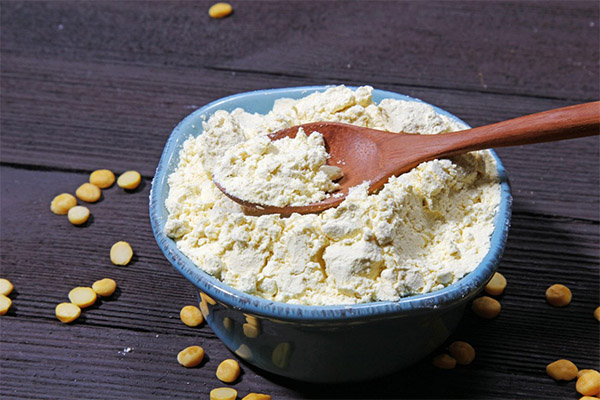
Pea flour has the following useful properties:
- General strengthening effect, including by strengthening the natural immunity.
- Improvement of skin condition due to the content of components such as lysine and pyridoxine.
- Normalization of the endocrine system.
- Prevention of premature aging due to antioxidants.
- Ensuring normal digestive processes, in which all the useful components obtained with the products are assimilated to the maximum extent.
- Elimination of constipation.
- Normalization of cholesterol levels in the blood.
- Prevent the formation of blood clots.
- Providing metabolic processes, which allows you to fight with excess weight.
- Improvement of cognitive abilities by stimulating brain activity.
For women, pea meal is useful because it contains calcium (11.5% of the daily norm), and this helps to strengthen bones, which is especially important during menopause to prevent the development of osteoporosis. It should also be noted that pea flour contains quite a lot of selenium, which, firstly, is an antioxidant that helps to slow down premature aging, and secondly, regulates the level of thyroid hormones and prevents the development of thyroid diseases. Finally, this product contains a lot of silicon (276% of the daily norm), and this substance is responsible for the production of collagen, which provides elasticity and youthfulness of the skin.
For men, pea flour is useful because it contains a sufficiently large amount of zinc - this helps to prevent inflammatory prostate diseases. You should also pay attention to the fact that there is a lot of selenium in the flour - this element helps to avoid diseases of the spine and joints.
Pea flour has a mild diuretic and choleretic effect, it is useful for many diseases. But before using it, it is recommended to consult a doctor, because, for example, with cholecystitis, accompanied by the formation of stones, these properties can even be harmful.
Pea flour is useful during pregnancy, and not only because it contains many B vitamins or highly digestible protein. It contains enough iron, which prevents the development of anemia that expectant mothers face. It also contains cobalt, which is responsible for the absorption of folic acid, necessary for normal fetal development.
Children of early age are not given pea meal, because their digestive system is not yet well enough developed to digest it. But pea flour is included in the diet of children over three years of age on a regular basis, starting with a small amount. It is especially useful for children suffering from celiac disease, because it does not contain gluten and at the same time contributes to their normal growth and development.
The medicinal uses of pea flour
Pea flour has a low glycemic index (35 units). Therefore, unlike wheat and rice flour, it can be used in case of type 2 diabetes. And in folk medicine it is even considered a cure for the disease. And there is a scientific explanation - pea flour contains chromium, which normalizes the sensitivity to insulin. It is recommended that you take 1/2 teaspoon of pea flour with water before meals.
In folk medicine, it is recommended to take pea flour 1 tbsp. three times a day to improve the skin and to fight obesity. However, doctors recommend starting with a smaller amount - at least 0.5-1 tsp. It is believed that this dosage will not only reduce the manifestations of diabetes, but also help get rid of headaches, as well as serve as a preventive measure against atherosclerosis and improve brain function.
Pea flour in cosmetology
Pea flour is used to prepare various cosmetics for the skin of the face or hands. It is also used for hair care. The main advantages of this ingredient are its versatility and multitasking. Flour is suitable for all skin types - for both dry, normal, oily and combination skin. It all depends on what will be diluted flour - water, milk, kefir, honey or base oils.
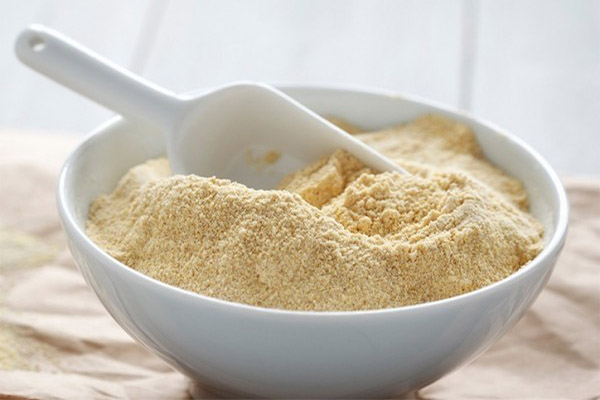
Important: when using homemade cosmetics, there is always a risk of developing an allergic reaction to any component. If after pea flour on the skin there is a red rash, there is irritation, accompanied by itching, then the procedure should be abandoned.
For face
You can do the following face masks:
- For dry and normal skin. For 300 g of pea flour take a little warm water to get a mush, and add milk to the consistency of thick sour cream. The resulting mixture is kept on low heat for 30 minutes, stirring occasionally. The mixture is then cooled and 5-7 drops of essential oil of rosemary are added. Mask applied to the face, leave for 15 minutes, then wash with warm water.
- For oily skin. The pea flour is mixed with slightly heated kefir or ryazhenka so that the mass is not too thick. The product is applied to the skin for 15 minutes, then wash without the use of cosmetics. Please note that the mask will give a slight whitening effect, which can be enhanced by adding a little fresh lemon juice.
- Rejuvenating mask. Pea flour is mixed with honey in equal proportions. The mixture is applied to the face for 15-20 minutes, then washed off with warm water.
After all the above masks is recommended to wash a second time already with cold water to narrow pores.
For hair
On the basis of pea flour and colorless henna you can make a mask to strengthen and stimulate hair growth. For 2 tablespoons of flour, take the same amount of colorless henna and 1 tablespoon of burdock or olive oil, as well as one fresh egg yolk. All ingredients are mixed, add a little warm water to the consistency of sour cream. The mask is heated for half a minute in the microwave, applied to damp hair for half an hour, then washed off without shampoo.
In traditional Chinese hair care there is a procedure using pea flour, which helps to cleanse the hair and scalp without drying them out. For this purpose, they take pea flour and pour warm water to the consistency of thick sour cream (to avoid lumps, it is necessary to stir constantly). Then leave to infuse for the night. In the morning, the resulting mass is applied to the scalp and hair along its length and leave for half an hour, and then wash off with warm water without the use of shampoos and balms. This tool is shown for oily hair, as it helps to remove excess sebum.
Harm and contraindications
Pea flour contains no harmful substances. However, when consumed in large quantities, such troubles as flatulence, bloating, digestive disorders can occur.
Contraindications:
- Pea flour on a regular basis is not recommended for elderly people if they have digestive problems.
- Pea flour is contraindicated in kidney diseases, including acute nephritis. It is undesirable to include it in the menu at acute cholecystitis.
- In acute pancreatitis, gastritis, ulcers and other inflammatory gastrointestinal diseases pea flour is contraindicated. But it can be included in small quantities in the diet in the chronic form of these diseases, under the condition of stable remission. And, of course, it is necessary to consult a doctor beforehand.
How to choose and store
When choosing any flour, it is very important to check the integrity of the packaging, otherwise there is a risk that there is moisture inside. Moreover, the packaging should be made of paper, because the flour in polyethylene does not breathe. Before buying, you should also check the expiration date. Pea flour is not stored for a long time, so do not take it as a reserve.
Most appreciated is the so-called pea flour in the old Russian style, it is the flour of coarse grinding, or whole grain, it is the most useful. In the store, of course, you can not look at it, but in general you should know that high-quality pea flour should have a light beige color. And the higher the degree of grinding, the higher its grade and the lighter the color. Of course, you should immediately check that the flour does not have any dark dots, lumps, bugs, etc.
Good pea flour, which has been stored properly, is not bitter, it has no sourness, the taste can be characterized as slightly sweet. There should be no aftertaste of mustiness or unpleasant odor, just as there should be no feeling of sand on the teeth when tasting it. When dry, the flour should not smell at all, but if you pour a little hot water on it, there will be a characteristic smell of peas.
Pea flour can be checked in the following way: take a small amount of the product and squeeze it in your hand. Good quality flour will not form lumps. Wet flour will stick to the skin.
It is recommended to store pea flour either in paper bags, or in cloth bags, in a dry dark place, so that it does not oxidize and does not gain moisture.
How to make pea flour at home
Pea flour can be made at home from dried pea kernels. The easiest option is to grind dried peas in a coffee grinder to a powder. It is not possible to get a large amount of flour at once in this way, but it is a good option for adding to casseroles or for medicinal and cosmetic purposes.

There is also a more complicated version, but the flour turns out more delicate, and the dishes are more delicious. To prepare in this way, cook pea porridge (from dried peas) and grind it in a blender. Then the resulting puree is placed on a baking tray and dried in the oven at the lowest possible temperature. From time to time the mass is stirred. As a result, you will get a powder of soft consistency, devoid of characteristic smell. Even sweets and pastries can be made from it.
Regardless of the method by which the pea flour was obtained, it should first be spread out on a white cloth, distributing on the surface an even layer not thicker than 2 cm. This flour should rest in a dry place for a while, so that the residual moisture can evaporate. If it easily comes off the skin of your hands, it means that it is completely ready. But it is still recommended to sift it before using it.
What you can make from pea flour: recipes
Pea flour is a great dietary product. In the process of cooking it retains all the useful substances, for which it is valued. At the same time, it practically does not absorb fat. Pea flour is used to make soups, pancakes and pancakes. However, for baking it is better to combine it with other flour, not necessarily wheat flour, you can use oat flour or buckwheat flour.
Fritters
Fritters made with pea flour are popular in traditional Indian cooking. To make them, 5 tablespoons of oat flour, buckwheat flour or wheat flour are used for 10 tablespoons of pea flour. You will also need the following ingredients: 1 tomato, 1 garlic clove, 1 tsp. chopped ginger root or the appropriate amount of powder, salt and turmeric to taste.
Mix flour and dry spices in a bowl, then add cold water a little at a time, a thin stream, so that you get a thick enough batter for fritters. The tomato is removed from the skin and chopped in a blender with the herbs, and then added to the resulting batter. It should not be light, you should achieve its elasticity, if necessary, add a little flour. Form the dough into pancakes and fry on both sides in a non-stick pan.
Pancakes
Pea flour pancakes can be made with either water or kefir. There are other recipes, such as Indian pancakes with ginger, but they are not as popular.
If you cook pancakes on water, you get a kind of unleavened flatbread, which can be served with a vegetable salad, with sour milk products or fried onions. Take 200 g of pea flour, 1 egg, salt to taste. Mix egg with flour and add warm water to make a sour cream consistency. Then the pancakes are baked as usual, from wheat flour. You can add sugar to the batter, then serve them better with honey or jam.
The second option - pancakes on kefir. This dish contains 5 tablespoons of pea flour and 3 tablespoons of wheat flour, 200 ml of kefir, 1 egg, salt and oil to taste. Both types of flour are mixed and sifted, then the egg and kefir are added. If necessary, you can add a little water, so that the mixture is not thick. Then bake the pancakes in a pan in the usual manner.
Porridge
Pea flour porridge is cooked both on the stove and in the multicooker. The proportion is as follows: 2 cups of water and 1 cup of pea flour. They are stirred so that a suspension is formed. Salt or sugar is added to taste. When cooking on the stove, the suspension is boiled on medium heat until it is mashed. When cooking in a multicooker, select the mode "Porridge" or "Stew". At the same time, additives to porridge can be different - for example, celery root stewed with carrots and onions, mushrooms stewed in sour cream, etc. Only with meat is not recommended to combine this product because of the high content of vegetable protein. Sweet porridge can be served with honey and dried fruits.
Soup
Soup made from pea flour is very simple to cook. It can be a soup puree, for which you need 6 tbsp of flour per 1 liter of water, salt, spices and herbs to taste. Then you just need to dissolve the flour with water so that there are no lumps, add salt and spices, bring it to a boil, stirring constantly, and serve with herbs.
The second option is to boil potatoes, onions and carrots, as for a regular soup. Dilute the pea flour with water until lumps disappear, add to the half-cooked vegetables, bring to a boil and serve with herbs.
Kissel
In ancient times pea sourdough was made from dried peas in Russia. But from flour it is more delicate, and it can be used even by people with gastrointestinal diseases.
The proportion is classic - for 2 cups of peas take 5 cups of water and cook over low heat for 30-40 minutes. Salt and spices are added to taste. Then they are cooled, poured into a mold and left in the fridge for 3-4 hours to solidify. Many cooks suggest cooking pea kissel with mushrooms. In this case, the mushrooms and onions are fried separately. Frozen kissel is served to the table with mushroom topping. It is usually eaten by cutting into slices.
Interesting facts about peas
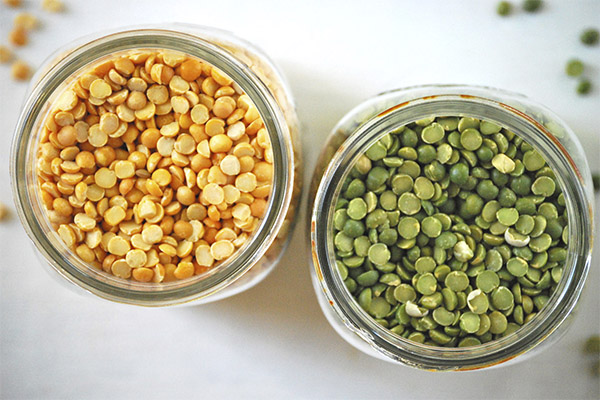
- There are only seven varieties of peas in the world, but they are one of the healthiest foods and contain a lot of fiber. But there are many more varieties of peas. Thomas Jefferson, the third president of the United States, is said to have grown several dozen varieties on his estate.
- Some scholars suggest that peas were one of the earliest crops grown by humans during the agrarian revolution 10,000 years ago. It is believed that it was first cultivated in the Mediterranean basin and the Far East. It is in these regions that it still plays a major role in cooking, although today it is distributed all over the world. It is most commonly cultivated in China and Russia, but Canada is also in the top three. Some varieties of sown peas can grow up to 2 m tall.
- Peas are high in protein. In the 19th and 20th centuries, this property was used to make ersatz sausage, which was part of the diet of German soldiers until World War II. However, in most cases it still had lard or meat added to it.
«Important: All information on this site is provided for informational purposes only. for educational purposes. Please consult with a health care professional before using any of our recommendations. specialist before applying any of the recommendations. Neither the editors nor the authors shall be liable for any possible harm caused by materials."

